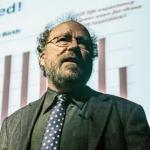When I conducted an assessment of Senator Bernie Sanders’ economic proposals and found that they could produce robust growth, the negative reaction among powerful liberal economists was swift and vehement. How much, I wondered, did this reflect personal disappointment being rationalized into a political economy of despair? Professional economists tend to embrace an economic theory that government can do little more than fuss around the edges. From that stance, what do they have to offer ordinary people for whom the economy is not working? Not a whole lot.
It has certainly been a rough seven years for the liberal economists in the Obama Administration. Economic recovery has been slow, the slowest in the post-World War II era. Ambitious programs for reform of social insurance programs (such as unemployment insurance) and for public investment have been scaled back, and back. Yes, there is much that these economists who served Obama can be proud of: more people have health insurance, and the economy did not collapse. But the constant slog must have taken a toll. Having experienced so many compromises and disappointments, perhaps it is easier to say to those who expect more that it just can’t happen. There is comfort in the Thatcherite phrase: There Is No Alternative (TINA).
The angry reaction to my report revealed that by some combination of rationalization and the dominance of neoclassical microeconomics since the 1970s, liberal economists have virtually abandoned Keynesian economics, which supported the notion that governments can and must intervene in the economy to ensure the best results for society. These economists went back to pre-Keynesian thinking, where price fluctuations are supposed to equilibrate supply and demand at full employment with an optimal distribution of good and services. The very suggestion that government action can result in increases in growth rates or wages is now taken to be obviously wrong. Adopting the language of neoclassical micro welfare economics, everything is already as good as can be — all that government can do is to make it worse. Criticisms of the orthodox model and its policies are deemed worthy of scorn, to be dismissed tout court because they are obviously at variance not only with textbook economics, but with what we need to believe to rationalize failure.
The closing of the economists’ mind
The reaction to my paper — the casual and precipitous conclusion that it must be wrong because it projects a sharply higher rate of GDP growth — comes from the assumption that the economy is already at full employment and capacity output. It is assumed that were output significantly below full employment, then prices would fall to equilibrate the two. This is the political counsel of despair. It is based on classical economic theory and the underlying acceptance of Say’s Law of Markets (named for the great Classical economist Jean-Baptiste Say), which says that total supply of goods and services and the total demand for goods and services will always be equal. The shoe market creates the right amount of demand for shoes — it works out so neatly that the true measure of the supply of shoes, of potential output, can be taken by measuring actual output. This concept is used as a justification for laissez-faire economics, and the view that the market mechanism finds a harmonious equilibrium. It explains why even in the depths of the economic crisis, Christina Romer, former Chair of the Council of Economic Advisers in the Obama administration, who was always skeptical of fiscal policy and Keynesian economics, and why Jared Bernstein, former Chief Economist and Economic Adviser to Vice President Joseph Biden under Obama, who should have known better, wrote that the economy would return on its own to full employment. They predicted, quite wrongly, that the proposed Obama stimulus would accelerate this recovery by 6 months.
The return of Say’s Law has distorted the way liberal policy elites view the economy. Consider the Congressional Budget Office’s (CBO) decision in 2014 to explain away years of slow growth by dramatically revising downwards its estimate of potential output. No longer do we have an output gap of 9 percent; instead the gap was redefined as only 2 percent because the real level of capacity is reevaluated as the level actually produced on the assumption that we must be at full employment. And how do we know that we are at full employment? Because we are producing the capacity level of output.
CBO has similarly downgraded estimates of potential GDP growth with historically low rates of labor force growth and slow productivity growth; instead of the 3 percent average annual growth of the 1959-2007 period, or the 4 percent growth 1947-73, we are to expect no more than 2 percent growth. While there is some referencing of demographic changes, these estimates conveniently align future growth projections with the otherwise-disappointing recent growth performance. This reevaluation says to policy elites, “Hey, we are doing as well as can be expected.” To the general public it says, “Sorry, nothing more can be done for you.” TINA.
The economics and politics of despair
There is, of course, a politics as well as a psychology to this economic theory. If nothing much can be done, if things are as good as they can be, it is irresponsible even to suggest to the general public that we try to do something about our economic ills. The role of economists and other policy elites (Paul Krugman is fond of the term “wonks”) is to explain to the general public why they should be reconciled with stagnant incomes, and to rebuke those, like myself, who say otherwise before we raise false hopes that can only be disappointed. But this approach leaves liberals like Hillary Clinton with few policy options to offer in response to the siren call of demagogues like Donald Trump. And it makes the work of self-proclaimed “responsible” elite economists that much more pressing. They have to work even harder to persuade the public that nothing can be done to head off the challenge of Trump and other irresponsible politicians who capitalize on the electorate’s appetite for change. They have to slap down critics like myself. “Responsible” elite economists have to keep the party of “good arithmetic” from overpromising at all costs.
Were the orthodox classical economists correct, then of course their politics would follow. But what if they are wrong? What if government action could, in fact, raise growth rates or narrow disparities? What would be the expected value of a higher GDP growth rate? Would it be worth some academic debate, even if it leaked into the public realm? Might this debate even serve a socially useful function by giving voters an alternative to the xenophobic political economy of Donald Trump? Many Americans believe that government action can improve economic conditions, especially for workers, and many of these support Trump because they see him as the only candidate who is even willing to consider government action to help working Americans. These voters can look long and hard at the “responsible” Clinton platform for some policy, for any policy to raise growth rates and narrow income disparities. But they won’t find it, because policy elites have closed their minds to the possibility of change.
An agenda for further research?
I admit that I have always lived surrounded by people who agree with me. At Columbia, Harvard, and now Amherst, Massachusetts, I have sought friends and colleagues who largely agree with me. While I enjoy the comfort that comes from an affirming community, it may be that I was not well served by the homogeneity of views. While I knew intellectually that the mainstream had abandoned Keynes and reembraced Say’s Law, I didn’t take this shift seriously. It seemed too absurd to me; honestly, I thought they were only kidding. Since I have spent most of my life refuting classical economics, and since my colleagues and friends agreed with me, I assumed that everyone did.
Had I included some mainstream economists in my narrow social circle, then I would have been better prepared for the substantive reaction to my report. On the other hand, as an intellectual activity, I was well served by the debate because it forced me to deal with ideas that I had previously rejected only too casually. I was helped in this by some of the orthodox folks who expressed second thoughts about my work (such as Kevin Drum). I am grateful to the Christina Romer and her husband David Romer, and to Justin Wolfers because, while they remain firmly opposed to my work, they took the time to explain their approach and helped me to articulate my own views more clearly. Our respectful exchanges allowed me to help them to understand the points of divergence in our models and gave me insight into the nature of my own approach.
This engagement of alternative visions could be a useful basis for the type of rethinking of macroeconomics favored even by some who remain in the orthodox camp, such as Olivier Blanchard, former chief economist at the International Monetary Fund,.
The debate has identified certain areas for empirical investigation that might help us not only to choose between the models but perhaps to find times and places where one or the other approach may be more useful. At a minimum, we have a research agenda for many graduate student papers and dissertations.
- The strength of Verdoorn’s Law associating productivity growth with economic growth rates and the level of labor shortage.
- The impact of pro-growth government investment policies – including investment in Research and Development as well as investments in roads, bridges, and other public utilities.
- The investment accelerator and its role in fiscal stimulus, or in theories of secular stagnation.
- The determinants of changes in labor force participation and the effect of increasing employment opportunities.
- Responsiveness of immigration, especially undocumented, to labor demand.
- The sensitivity of US imports to economic growth, an issue complicated by the international role of the dollar.
Restoring controversy to economics
Controversy reflects the disagreements and uncertainty that alone can lead to intellectual progress. It is time to inject some of these into orthodox macroeconomics. We have been ill-served by a smugly sure macroeconomics both in imagination and policy. Amazingly, the crisis of 2007-9 has left intact the dominant pseudo-Keynesian orthodoxy; maybe the kerfuffle around my report will help to open some space for constructive dialog in a profession that has clearly grown too complacent.





